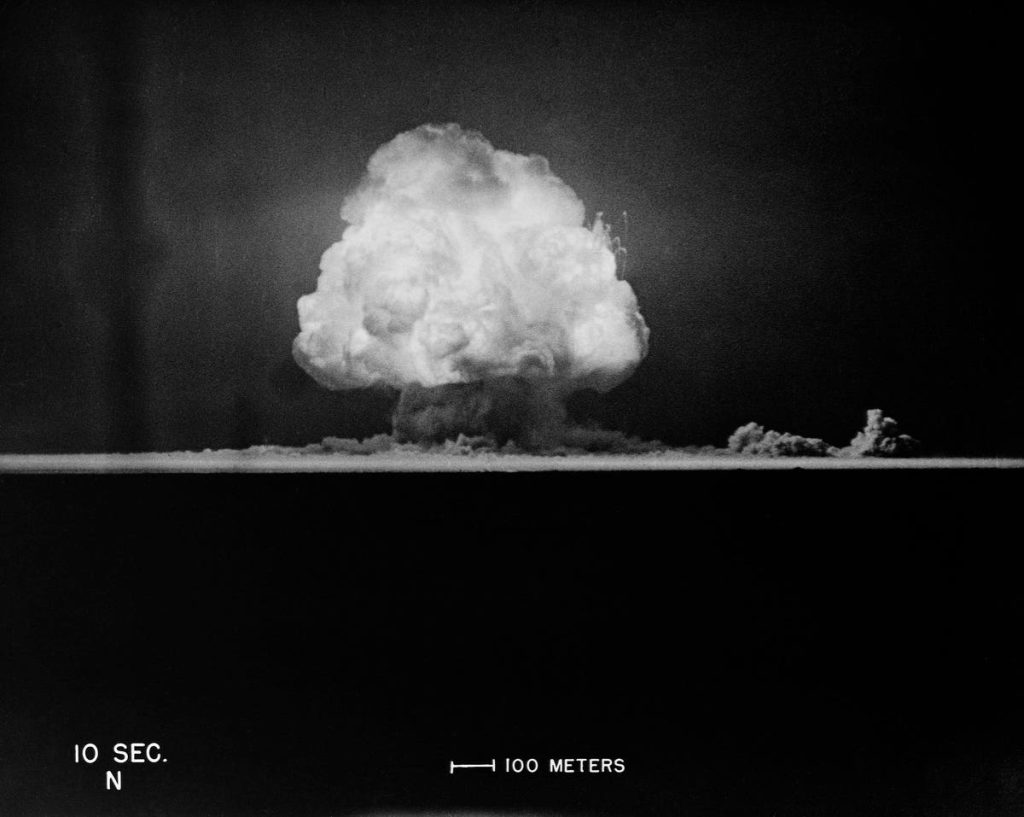On July 16, 1945, at 5:29:45 a.m. the first atomic bomb exploded at the Trinity test site in the desert of New Mexico. It was the result of an unprecedented arms race under the secret Manhattan Project as retold by the new movie “Oppenheimer.”
The explosion resulted in an unprecedented release of energy – the equivalent of 20,000 tons of TNT exploding in less than 10 seconds. Even though the bomb was detonated from the top of a 30- meter steel tower, the blast created a crater over 2 meters deep and 40 meters wide. And all around the crater the ground was covered with a material never seen before.
“The glass, in general, formed a layer 1 to 2 centimeters thick, with the upper surface marked by a very thin sprinkling of dust which fell upon it while it was still molten. At the bottom is a thicker film of partly fused material, which grades into the soil from which it was derived. The color of the glass is a pale bottle green, and the material is extremely vesicular, with the size of the bubbles ranging to nearly the full thickness of the specimen,” as a contemporary report by USGS geologist Clarence S. Ross notes.
Because it was a fission bomb filled with plutonium and uranium, a variety of different radioactive isotopes and elements were released by the detonation. Desert sand contains mostly grains of quartz, feldspar, with small crystals of calcite, hornblende, and augite mixed in. The initial burst of intense radiation, reaching temperatures over 8,400°K, vaporized much of the superficial layers of the desert, mixing the elements from the vaporized minerals with the elements produced by the nuclear reactions, and forming a new and unique chemical mix. Raining down in liquid form and quickly cooling, a glassy layer extending to a radius of 300 meters around the explosion site formed and a new mineral was born – Trinitite, after the site of its formation/discovery.
The successful test not only ushered the world into the atomic age, but led to a quick end of the war in the Pacific, after two atom bombs were dropped on the Japanese cities of Hiroshima and Nagasaki.
In the early morning of August 6, 1945 the atomic bomb “Little Boy”exploded over Hiroshima, a city of 350,000 people situated on a coastal plain in the Chugoku region of western Honshu, Japan. The enormous blast instantly destroyed most of the city and claimed some 70,000 lives.
“Man unleashed the atom to destroy man, and another chapter in human history opened,” wrote the New York Times the next day. The Hiroshima bombing not only changed human history, but like the Trinity test created a new kind of minerals that may even enter the geological record.
In 2015, geologist Mario Wannier visited the shores near Hiroshima to collect some sand samples. Searching for microfossils, he discovered small particles of melted metal, glass beads and fragments of a rubber-like substance in the samples collected on Miyajima Island and Motoujina Peninsula. Together with researchers at the Lawrence Berkeley National Laboratory, Wannier studied the mineralogical composition of the particles, discovering that they likely formed when the atomic blast vaporized parts of Hiroshima.
A chemical analysis showed an unusual composition of the particles, mostly composed of aluminum, silica, iron and calcium. Crystallographic analysis, used to identify the crystalline structure of an unknown substance, showed similarities to minerals with a high-temperature origin (over 1,800°C). The researchers argue that the particles formed by condensation from the mushroom cloud after the nuclear blast, explaining the high-temperature origin and mixed chemical composition, as the cloud contained a mix of elements from vaporized human-made materials like steel, concrete and rubber. The researchers named the mineral-mix Hiroshimaites.
Unlike naturally occurring tektites, glass fragments formed by a meteorite impact, or obsidian, a type of volcanic glass, the minerals created by an atomic blast are unique.
Even if the deploy of nuclear devices in wartime is limited so far to Japan, Hiroshimaites and other minerals generated by the blast of an atomic device may be found in former test sites of nuclear powers across the planet, like the desert of the United States, in Siberia, the mountains of North Korea, India, Pakistan, the desert of Australia and atolls of the Pacific.
The detonation of a nuclear device and mining of uranium and other fissile material released large quantities of radioactive dust into Earth’s atmosphere. As this dust settles on the ground, it leaves behind a radioactive signature in the rocks that can be detected by geologists everywhere.
Some researchers suggest to use the appearance of radioactive minerals associated with human technology to mark the beginning of the Anthropocene – the newest geological epoch in Earth’s history.
Read the full article here










